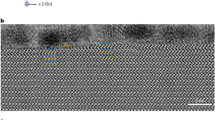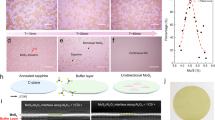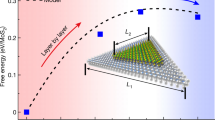Abstract
Two-dimensional (2D) semiconductors, in particular transition metal dichalcogenides (TMDCs), have attracted great interest in extending Moore’s law beyond silicon1,2,3. However, despite extensive efforts4,5,6,7,8,9,10,11,12,13,14,15,16,17,18,19,20,21,22,23,24,25, the growth of wafer-scale TMDC single crystals on scalable and industry-compatible substrates has not been well demonstrated. Here we demonstrate the epitaxial growth of 2 inch (~50 mm) monolayer molybdenum disulfide (MoS2) single crystals on a C-plane sapphire. We designed the miscut orientation towards the A axis (C/A) of sapphire, which is perpendicular to the standard substrates. Although the change of miscut orientation does not affect the epitaxial relationship, the resulting step edges break the degeneracy of nucleation energy for the antiparallel MoS2 domains and lead to more than a 99% unidirectional alignment. A set of microscopies, spectroscopies and electrical measurements consistently showed that the MoS2 is single crystalline and has an excellent wafer-scale uniformity. We fabricated field-effect transistors and obtained a mobility of 102.6 cm2 V−1 s−1 and a saturation current of 450 μA μm–1, which are among the highest for monolayer MoS2. A statistical analysis of 160 field-effect transistors over a centimetre scale showed a >94% device yield and a 15% variation in mobility. We further demonstrated the single-crystalline MoSe2 on C/A sapphire. Our method offers a general and scalable route to produce TMDC single crystals towards future electronics.
This is a preview of subscription content, access via your institution
Access options
Access Nature and 54 other Nature Portfolio journals
Get Nature+, our best-value online-access subscription
$29.99 / 30 days
cancel any time
Subscribe to this journal
Receive 12 print issues and online access
$259.00 per year
only $21.58 per issue
Buy this article
- Purchase on Springer Link
- Instant access to full article PDF
Prices may be subject to local taxes which are calculated during checkout





Similar content being viewed by others
Data availability
The data that support the findings of this study are available from the corresponding authors upon reasonable request.
References
Fiori, G. et al. Electronics based on two-dimensional materials. Nat. Nanotechnol. 9, 768–779 (2014).
Manzeli, S., Ovchinnikov, D., Pasquier, D., Yazyev, O. V. & Kis, A. 2D transition metal dichalcogenides. Nat. Rev. Mater. 2, 17033 (2017).
Akinwande, D. et al. Graphene and two-dimensional materials for silicon technology. Nature 573, 507–518 (2019).
Liu, K.-K. et al. Growth of large-area and highly crystalline MoS2 thin layers on insulating substrates. Nano Lett. 12, 1538–1544 (2012).
Najmaei, S. et al. Vapour phase growth and grain boundary structure of molybdenum disulphide atomic layers. Nat. Mater. 12, 754–759 (2013).
Van der Zande, A. M. et al. Grains and grain boundaries in highly crystalline monolayer molybdenum disulphide. Nat. Mater. 12, 554–561 (2013).
Liu, Z. et al. Strain and structure heterogeneity in MoS2 atomic layers grown by chemical vapour deposition. Nat. Commun. 5, 5246 (2014).
Gao, Y. et al. Large-area synthesis of high-quality and uniform monolayer WS2 on reusable Au foils. Nat. Commun. 6, 8569 (2015).
Kang, K. et al. High-mobility three-atom-thick semiconducting films with wafer-scale homogeneity. Nature 520, 656–660 (2015).
Chen, J. et al. Chemical vapor deposition of large-size monolayer MoSe2 crystals on molten glass. J. Am. Chem. Soc. 139, 1073–1076 (2017).
Yang, P. et al. Batch production of 6-inch uniform monolayer molybdenum disulfide catalyzed by sodium in glass. Nat. Commun. 9, 979 (2018).
Li, S. et al. Vapour–liquid–solid growth of monolayer MoS2 nanoribbons. Nat. Mater. 17, 535–542 (2018).
Zhou, J. et al. A library of atomically thin metal chalcogenides. Nature 556, 355–359 (2018).
Fu, D. et al. Molecular beam epitaxy of highly crystalline monolayer molybdenum disulfide on hexagonal boron nitride. J. Am. Chem. Soc. 139, 9392–9400 (2017).
Zhang, X. et al. Defect-controlled nucleation and orientation of WSe2 on hBN: a route to single-crystal epitaxial monolayers. ACS Nano 13, 3341–3352 (2019).
Wang, L. et al. Epitaxial growth of a 100-square-centimetre single-crystal hexagonal boron nitride monolayer on copper. Nature 570, 91–95 (2019).
Chen, T.-A. et al. Wafer-scale single-crystal hexagonal boron nitride monolayers on Cu(111). Nature 579, 219–223 (2020).
Dumcenco, D. et al. Large-area epitaxial monolayer MoS2. ACS Nano 9, 4611–4620 (2015).
Yu, H. et al. Wafer-scale growth and transfer of highly-oriented monolayer MoS2 continuous films. ACS Nano 11, 12001–12007 (2017).
Aljarb, A. et al. Substrate lattice-guided seed formation controls the orientation of 2D transition-metal dichalcogenides. ACS Nano 11, 9215–9222 (2017).
Suenaga, K. et al. Surface-mediated aligned growth of monolayer MoS2 and in-plane heterostructures with graphene on sapphire. ACS Nano 12, 10032–10044 (2018).
Zhang, X. et al. Diffusion-controlled epitaxy of large area coalesced WSe2 monolayers on sapphire. Nano Lett. 18, 1049–1056 (2018).
Wang, Q. et al. Wafer-scale highly oriented monolayer MoS2 with large domain sizes. Nano Lett. 20, 7193–7199 (2020).
Yang, P. et al. Epitaxial growth of centimeter-scale single-crystal MoS2 monolayer on Au(111). ACS Nano 14, 5036–5045 (2020).
Choi, S. H. Epitaxial single-crystal growth of transition metal dichalcogenide monolayers via the atomic sawtooth au surface. Adv. Mater. 33, 2006601 (2021).
Nakamura, S. & Krames, M. R. History of gallium–nitride-based light-emitting diodes for illumination. Proc. IEEE 101, 2211–2220 (2013).
Lytvynov, L., Single Crystals of Electronic Materials (ed. Fornari, R.) 447–485 (Woodhead Publishing, 2019).
Doucette, L. D., Cunha, M. P. D. & Lad, R. J. Precise orientation of single crystals by a simple X-ray diffraction rocking curve method. Rev. Sci. Instrum. 76, 036106 (2005).
Hwang, Y. & Shin, N. Hydrogen-assisted step-edge nucleation of MoSe2 monolayers on sapphire substrates. Nanoscale 11, 7701–7709 (2019).
Chubarov, M. Wafer-scale epitaxial growth of unidirectional WS2 monolayers on sapphire. ACS Nano 15, 2532–2541 (2021).
Mak, K. F. et al. Tightly bound trions in monolayer MoS2. Nat. Mater. 12, 207–211 (2013).
Yin, X. et al. Edge nonlinear optics on a MoS2 atomic monolayer. Science 344, 488–490 (2014).
Cheng, J. et al. Kinetic nature of grain boundary formation in as-grown MoS2 monolayers. Adv. Mater. 27, 4069–4074 (2015).
Hong, J. et al. Exploring atomic defects in molybdenum disulphide monolayers. Nat. Commun. 6, 6293 (2015).
Bets, K. V., Gupta, N. & Yakobson, B. I. How the complementarity at vicinal steps enables growth of 2D monocrystals. Nano Lett. 19, 2027–2031 (2019).
Dong, J., Zhang, L., Dai, X. & Ding, F. The epitaxy of 2D materials growth. Nat. Commun. 11, 5862 (2020).
Schweiger, H., Raybaud, P., Kresse, G. & Toulhoat, H. Shape and edge sites modifications of MoS2 catalytic nanoparticles induced by working conditions: a theoretical study. J. Catal. 207, 76–87 (2002).
Aljarb, A. et al. Ledge-directed epitaxy of continuously self-aligned single-crystalline nanoribbons of transition metal dichalcogenides. Nat. Mater. 19, 1300–1306 (2020).
Li, M.-Y., Su, S.-K., Wong, H.-S. P. & Li, L.-J. How 2D semiconductors could extend Moore’s law. Nature 567, 169–170 (2019).
Tang, H. et al. Recent progress in devices and circuits based on wafer-scale transition metal dichalcogenides. Sci. China Inf. Sci. 62, 220401 (2019).
Smithe, K. K. H., Suryavanshi, S. V., Muñoz Rojo, M., Tedjarati, A. D. & Pop, E. Low variability in synthetic monolayer MoS2 devices. ACS Nano 11, 8456–8463 (2017).
Smets, Q. et al. Ultra-scaled MOCVD MoS2 MOSFETs with 42 nm contact pitch and 250 µA/µm drain current. In Proc. 2019 IEEE International Electron Devices Meeting (IEDM) 23.2.1–23.2.4 (IEEE, 2019).
Perdew, J. P., Burke, K. & Ernzerhof, M. Generalized gradient approximation made simple. Phys. Rev. Lett. 77, 3865–3868 (1996).
Kresse, G. & Furthmüller, J. Efficient iterative schemes for ab initio total-energy calculations using a plane-wave basis set. Phys. Rev. B 54, 11169–11186 (1996).
Blöchl, P. E. Projector augmented-wave method. Phys. Rev. B 50, 17953–17979 (1994).
Grimme, S., Antony, J., Ehrlich, S. & Krieg, H. A consistent and accurate ab initio parametrization of density functional dispersion correction (DFT-D) for the 94 elements H–Pu. J. Chem. Phys. 132, 154104 (2010).
Ma, L. & Zeng, X. C. Catalytic directional cutting of hexagonal boron nitride: the roles of interface and etching agents. Nano Lett. 17, 3208–3214 (2017).
Zhao, W. & Ding, F. Energetics and kinetics of phase transition between a 2H and a 1T MoS2 monolayer—a theoretical study. Nanoscale 9, 2301–2309 (2017).
Acknowledgements
This work is supported by the Natural Science Foundation of Jiangsu Province (grant no. BK20202005), the National Key R&D Program of China (grant no. 2017YFA0204800), National Natural Science Foundation of China (grant nos 61927808, 61521001, 61734003, 61851401, 91964202, 61861166001, 51861145202; 51972162, 22033002, 21525311, 21903014, 11774153 and 11874199), Strategic Priority Research Program of the Chinese Academy of Sciences XDB 30000000, Key Laboratory of Advanced Photonic and Electronic Materials, Collaborative Innovation Center of Solid-State Lighting and Energy-Saving Electronics and the Fundamental Research Funds for the Central Universities, China.
Author information
Authors and Affiliations
Contributions
X.W. conceived and supervised the project. T.L. performed the CVD growth with assistance from L.L., Z.W., Y. Yang, W. Lin and N.D., and guidance from Y. Yao and Y.S. W.G. and Y.N. performed the RHEED, LEED and XRD characterizations and data analysis. L.M. and J.W. performed the density functional theory calculations. Z.H., S.G. and P.W. performed the TEM and data analysis. X.C. and Z.L. contributed to the spectral characterizations, including PL, Raman spectroscopy and SHG mapping. Z.Y., W. Li, D.F., X.T. and D.P. contributed to transistor fabrication, measurements and data analysis. T.L., J.W. and X.W. co-wrote the manuscript with input from other authors. All the authors contributed to discussions.
Corresponding authors
Ethics declarations
Competing interests
The authors declare no competing interests.
Additional information
Peer review information Nature Nanotechnology thanks Xiangfeng Duan, Joan Redwing and the other, anonymous, reviewer(s) for their contribution to the peer review of this work.
Publisher’s note Springer Nature remains neutral with regard to jurisdictional claims in published maps and institutional affiliations.
Supplementary information
Supplementary Information
Supplementary Figs. 1–21, Table 1 and References.
Rights and permissions
Springer Nature or its licensor (e.g. a society or other partner) holds exclusive rights to this article under a publishing agreement with the author(s) or other rightsholder(s); author self-archiving of the accepted manuscript version of this article is solely governed by the terms of such publishing agreement and applicable law.
About this article
Cite this article
Li, T., Guo, W., Ma, L. et al. Epitaxial growth of wafer-scale molybdenum disulfide semiconductor single crystals on sapphire. Nat. Nanotechnol. 16, 1201–1207 (2021). https://doi.org/10.1038/s41565-021-00963-8
Received:
Accepted:
Published:
Issue Date:
DOI: https://doi.org/10.1038/s41565-021-00963-8
This article is cited by
-
Phase-engineered synthesis of atomically thin te single crystals with high on-state currents
Nature Communications (2024)
-
Ready-to-transfer two-dimensional materials using tunable adhesive force tapes
Nature Electronics (2024)
-
Growth of millimeter-sized 2D metal iodide crystals induced by ion-specific preference at water-air interfaces
Nature Communications (2024)
-
Non-volatile rippled-assisted optoelectronic array for all-day motion detection and recognition
Nature Communications (2024)
-
Broadband nonlinear modulation of incoherent light using a transparent optoelectronic neuron array
Nature Communications (2024)



